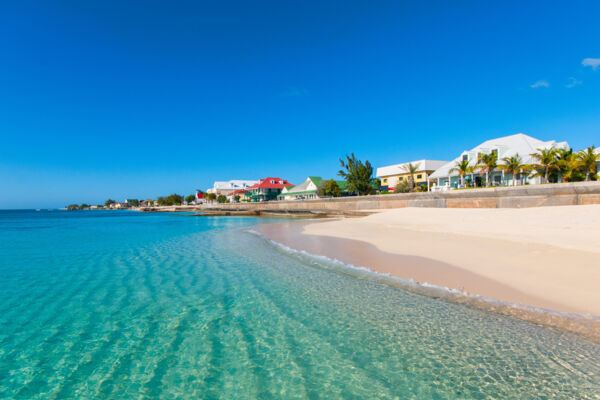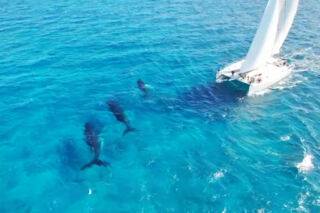Grand Turk Whale Watching

Although you might not initially expect it, Grand Turk (and the nearby island of Salt Cay) offers great humpback whale watching during the January to April winter months.
Every year, humpback whales migrate from the northern Atlantic to the warmer northern Caribbean waters to give birth and to mate.
The Turks and Caicos Islands are situated on an underwater plateau that rises 11,000 feet (3,350 m) from the surrounding ocean floor. Much of this extensive subterranean shelf is relatively shallow, but a deep channel splits this plateau and separates the Turks Islands from the Caicos Islands. Whales are funneled through this passage and consequently migrate quite close to Grand Turk.
Whale Watching Tours
Quite a few local businesses offer whale watching tours. Most of these trips are afternoon excursions, but custom tours can easily be arranged.
Snorkeling Encounters

Although not guaranteed, it’s possible that you’ll get the opportunity to snorkel with the whales, and we highly recommend that you take advantage of the chance if possible.
One truly impressive aspect of a snorkeling encounter with humpback whales isn't even seeing one of the giant marine mammals, it’s simply experiencing the deep blue ocean from under the surface.
From the boat, the deep Atlantic water off of Grand Turk appears a dark navy blue. Yet it takes on an incredibly vibrant and lighter shade when you're underwater as the sunlight refracts and reflects. On sunny days, the effect is even greater, with distinct rays piercing the depths.
Responsible Whale Watching Tips
As friendly as they can be, the humpback whales that migrate through the Turks and Caicos are, first and foremost, wild animals. The Turks and Caicos Department of Environment and Coastal Resources (DECR) has guidelines for interacting with marine mammals, such as dolphins and whales, in the islands. For the whales’ safety and for yours, it’s important to practice the following recommended behaviors when whale watching.
One of the benefits of whale watching in the Turks and Caicos is being able to get in the water with these majestic creatures. When snorkeling near a humpback whale:
- Wear snorkeling vests in the water.
- Avoid splashing your arms or legs excessively.
- Do not approach the whale—instead, let it approach you if it chooses to.
- Do not freedive into the whale's space.
- Do not try touching the whale, under any circumstances.
- Keep your distance from pregnant females to avoid being seen as a threat.
- If a marine mammal charges towards you, get out of the water immediately.
Whether you are in the water with a humpback whale or observing it from the deck of a tour boat, know that you should never litter in their environment or try to feed them. Feeding marine mammals is not only dangerous—it’s illegal under Turks and Caicos law.

